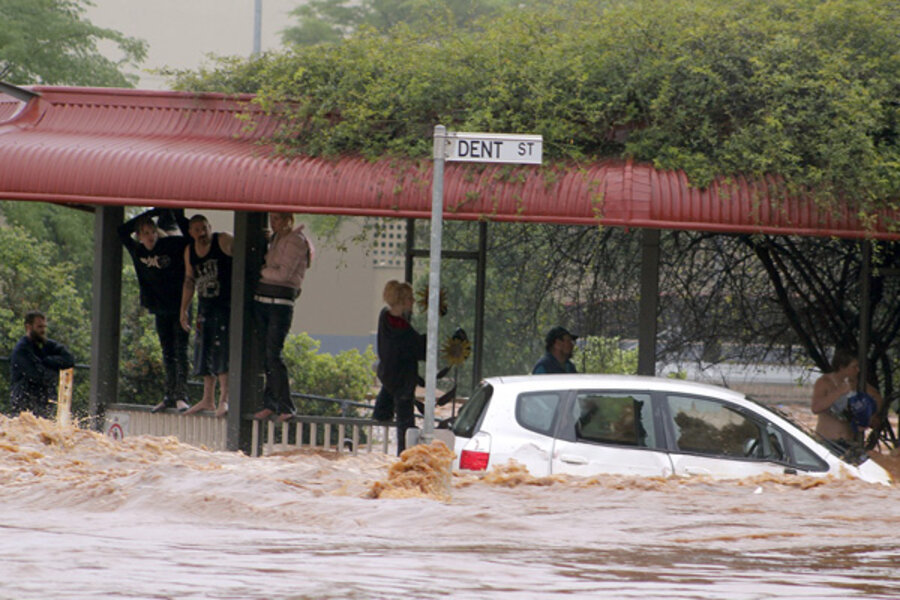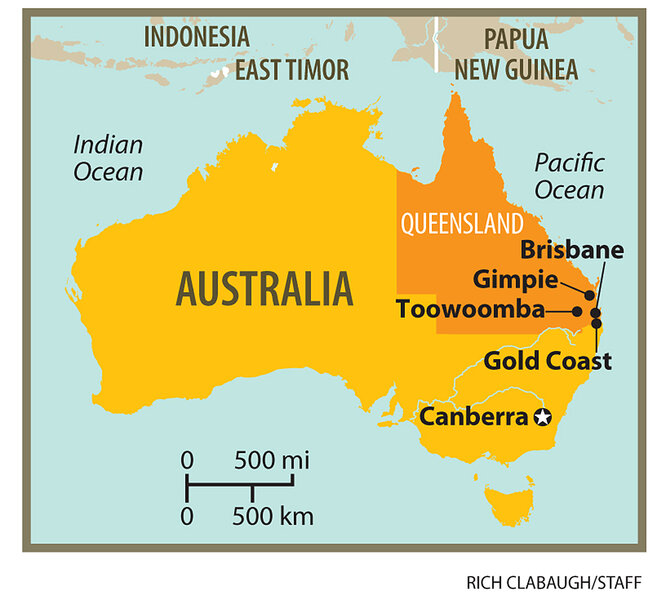Australia flooding racks up a hefty bill
Loading...
| Sydney
More Queensland towns – including popular seaside resorts on the state's Gold Coast – faced flooding Monday, threatening Australia's tourism industry and dealing a fresh blow to the Australian economy.
Economists have estimated the bill from the prolonged floods – the worst to hit Queensland for half a century – at $5.94 billion. But they say the real cost will be known only when the waters recede and the full extent of the damage to roads, railway lines, bridges, and homes. [Editors note: the original version of this article misstated the estimated cost of flooding.]
As well as destroying infrastructure and drenching more than 40 towns, the floods have paralyzed Australia’s biggest coal-mining region, which produces more than one-third of its coal exports. Vast quantities of crops have also been wiped out, to the frustration of farmers hoping for a bumper harvest after years of drought.
Now Queensland’s tourism industry – already under pressure because a strong Australian dollar has made the country more expensive – is at risk too. After 13 inches of rain fell in 24 hours on parts of the state, the Bureau of Meteorology (BOM) warned Monday that the Gold Coast – a magnet for international visitors – was in danger of receiving similarly torrential downpours.
Toowoomba, west of the state capital Brisbane, was the latest city to be hit, as flash floods raced through, killing at least seven people and sweeping cars off the roads. The city of Gympie, just inland from the Sunshine Coast, was also inundated, after the Mary River burst its banks.
The floods – which began before Christmas and have affected about 200,000 people across an area equivalent to half of Texas – have claimed a total of 17 lives. Nearly 4,000 residents have been evacuated, with many still living with relatives or in emergency centers. The federal government has spent almost $7 million so far on disaster relief payments to families.
Political recriminations and 'dam phobia'
As Queenslanders prayed for the rain to stop, the political recriminations began. Accusing Julia Gillard’s Labor government of “dam phobia,” the opposition leader, Tony Abbott, called for more dams to be built to minimize the effects of flooding. But his proposal was challenged by water management experts, who claim dams are not a solution and also harm the environment.
Willem Vervoort, a hydrology professor at the University of Sydney, says: “Over the last decade, we’ve realized that dams are not a very good way of controlling floods. International studies also show they have a lot of detrimental effects on rivers and their eco-systems, because they change the flow dynamics and the temperature of the water.”
According to Dr. Vervoort, research carried out in Germany and the United States, particularly since the devastating floods of 1993 in St Louis, Mo., has focused on “working with the water, for instance by rerouting it, rather than trying to control it through dams.”
With monsoonal rains forecast for the rest of this week, little relief is in sight yet for waterlogged Queensland. In low-lying areas of Brisbane, locals sandbagged their homes Monday against the rising waters. In Dalby, west of the capital, residents were evacuated as a second wave of flooding threatened homes already inundated two weeks ago.
The state’s vital coal-mining industry, meanwhile, remained virtually shut down, thanks to flooded mines and submerged roads and railways. In the ports, ships waited vainly offshore to transport coking coal – used in the manufacture of steel – to the steel mills of Asia. Australia is the source of two-thirds of the world’s coking coal exports.
With crops ruined and agricultural production in Queensland at a standstill, Australians have been warned to expect higher food prices. The cost of red peppers has already doubled, while other fruit and vegetables are up about 20 percent in the wholesale markets.
The silver lining?
But analysts say the floods will also have positive consequences for Australia, including pushing up world coal prices. For farmers, the increased moisture in the soil will be a long-term benefit.
In addition, the risk of bush fires in Queensland this summer is virtually zero, according to weather forecasters. A BOM spokesman says: “The bush fire season has effectively been canceled, because of how sodden the state is and has been for a long time.”






